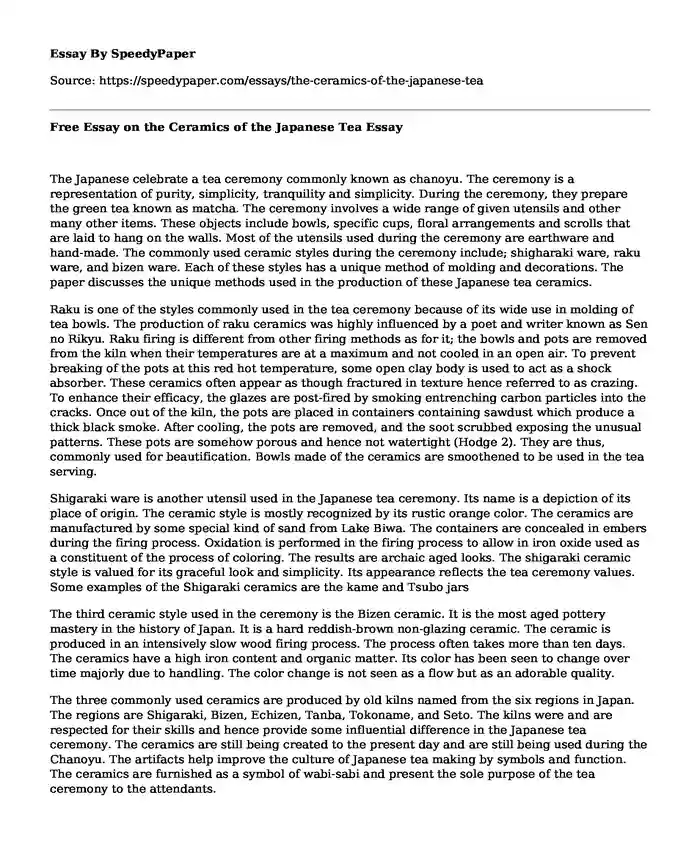The Japanese celebrate a tea ceremony commonly known as chanoyu. The ceremony is a representation of purity, simplicity, tranquility and simplicity. During the ceremony, they prepare the green tea known as matcha. The ceremony involves a wide range of given utensils and other many other items. These objects include bowls, specific cups, floral arrangements and scrolls that are laid to hang on the walls. Most of the utensils used during the ceremony are earthware and hand-made. The commonly used ceramic styles during the ceremony include; shigharaki ware, raku ware, and bizen ware. Each of these styles has a unique method of molding and decorations. The paper discusses the unique methods used in the production of these Japanese tea ceramics.
Raku is one of the styles commonly used in the tea ceremony because of its wide use in molding of tea bowls. The production of raku ceramics was highly influenced by a poet and writer known as Sen no Rikyu. Raku firing is different from other firing methods as for it; the bowls and pots are removed from the kiln when their temperatures are at a maximum and not cooled in an open air. To prevent breaking of the pots at this red hot temperature, some open clay body is used to act as a shock absorber. These ceramics often appear as though fractured in texture hence referred to as crazing. To enhance their efficacy, the glazes are post-fired by smoking entrenching carbon particles into the cracks. Once out of the kiln, the pots are placed in containers containing sawdust which produce a thick black smoke. After cooling, the pots are removed, and the soot scrubbed exposing the unusual patterns. These pots are somehow porous and hence not watertight (Hodge 2). They are thus, commonly used for beautification. Bowls made of the ceramics are smoothened to be used in the tea serving.
Shigaraki ware is another utensil used in the Japanese tea ceremony. Its name is a depiction of its place of origin. The ceramic style is mostly recognized by its rustic orange color. The ceramics are manufactured by some special kind of sand from Lake Biwa. The containers are concealed in embers during the firing process. Oxidation is performed in the firing process to allow in iron oxide used as a constituent of the process of coloring. The results are archaic aged looks. The shigaraki ceramic style is valued for its graceful look and simplicity. Its appearance reflects the tea ceremony values. Some examples of the Shigaraki ceramics are the kame and Tsubo jars
The third ceramic style used in the ceremony is the Bizen ceramic. It is the most aged pottery mastery in the history of Japan. It is a hard reddish-brown non-glazing ceramic. The ceramic is produced in an intensively slow wood firing process. The process often takes more than ten days. The ceramics have a high iron content and organic matter. Its color has been seen to change over time majorly due to handling. The color change is not seen as a flow but as an adorable quality.
The three commonly used ceramics are produced by old kilns named from the six regions in Japan. The regions are Shigaraki, Bizen, Echizen, Tanba, Tokoname, and Seto. The kilns were and are respected for their skills and hence provide some influential difference in the Japanese tea ceremony. The ceramics are still being created to the present day and are still being used during the Chanoyu. The artifacts help improve the culture of Japanese tea making by symbols and function. The ceramics are furnished as a symbol of wabi-sabi and present the sole purpose of the tea ceremony to the attendants.
Works cited
"Chanoyu: Ceramics of the Japanese Tea Ceremony | Art Appraisers - MIR Appraisal Services - Fine Art Antiques Jewelry Personal Property In Chicago." Chanoyu: Ceramics of the Japanese Tea Ceremony | Art Appraisers - MIR Appraisal Services - Fine Art Antiques Jewelry Personal Property In Chicago. Appraisal Service, INC, 19 Feb. 2015. Web. 10 Apr. 2016.
Hodge Stephanie. Japanese Tea Bowls: High School Studio Lesson. (2011): 1-2. Web. https://www.davisart.com/Promotions/SchoolArts/PDF/12_11_high-school-studio-art-lesson-plan-japanese-tea-bowls.pdf
Cite this page
Free Essay on the Ceramics of the Japanese Tea. (2019, Aug 28). Retrieved from https://speedypaper.net/essays/the-ceramics-of-the-japanese-tea
Request Removal
If you are the original author of this essay and no longer wish to have it published on the SpeedyPaper website, please click below to request its removal:
- Essay Example on the Role of the Federal Reserve
- Free Essay with the UVA Transfer Application Letter
- Collective Bargaining in Education, Free Essay for Everyone
- Essay Example: Rationale Behind My Choice to Invest in Tesco and Lloyds Bank
- Free Essay Sample on Childhood-Onset Fluency Disorder (Stuttering)
- Is Trump the Only One to Blame for the Trade War Between USA and China? Paper Example
- Paper Example on Civil Disobedience in Solving a Social Injustice
Popular categories





